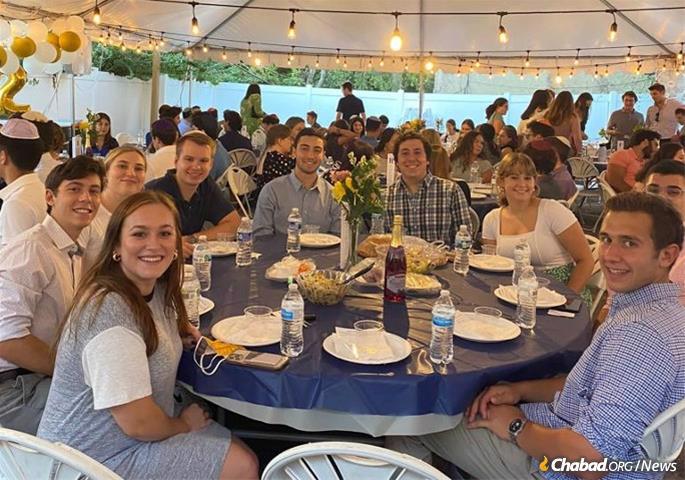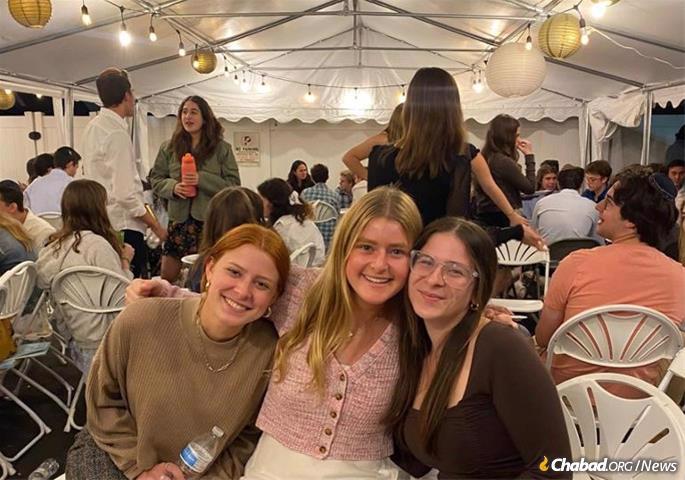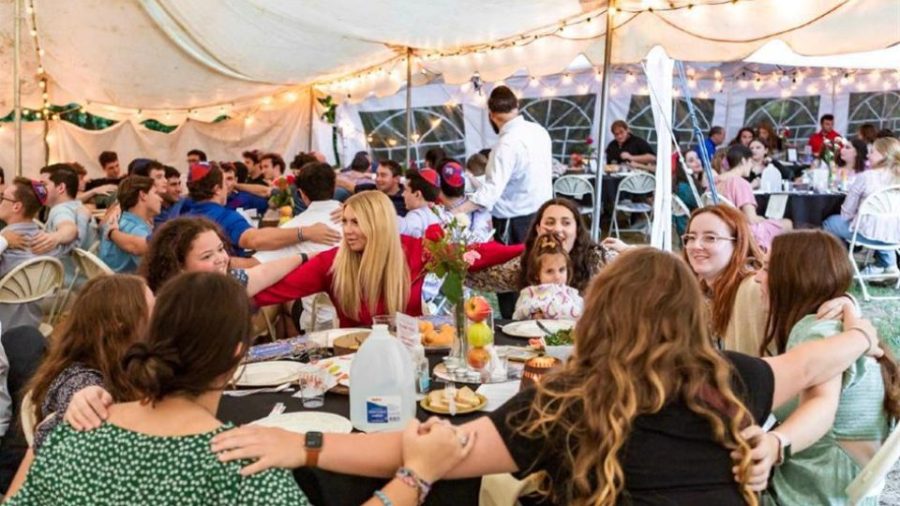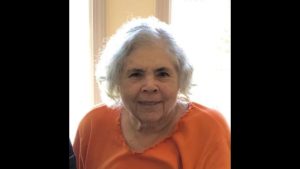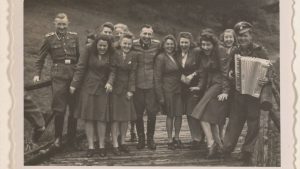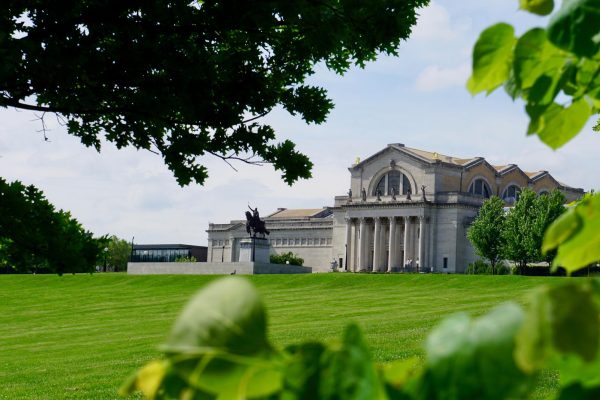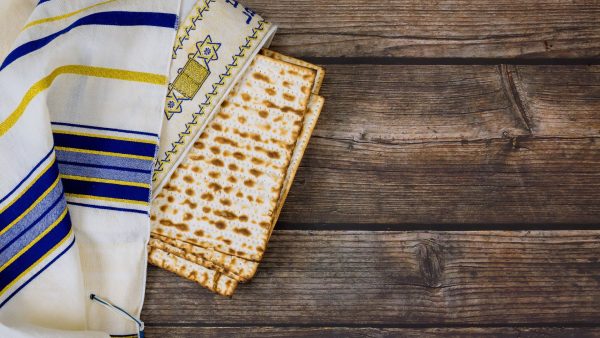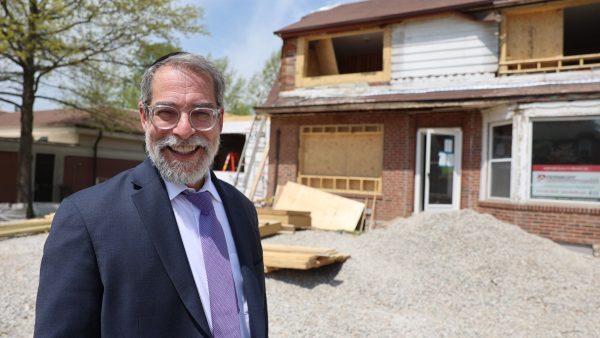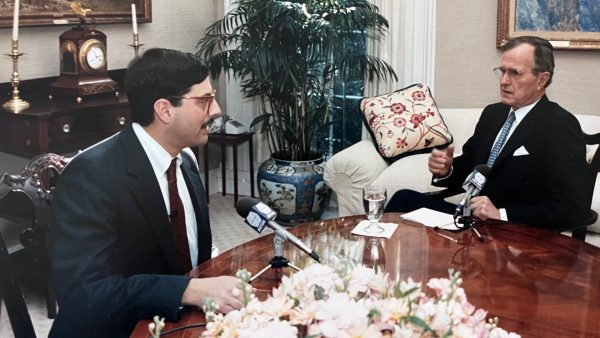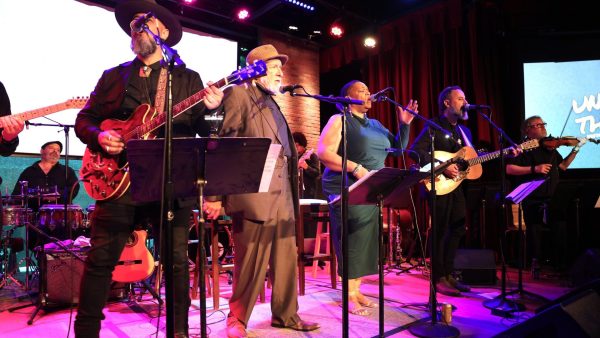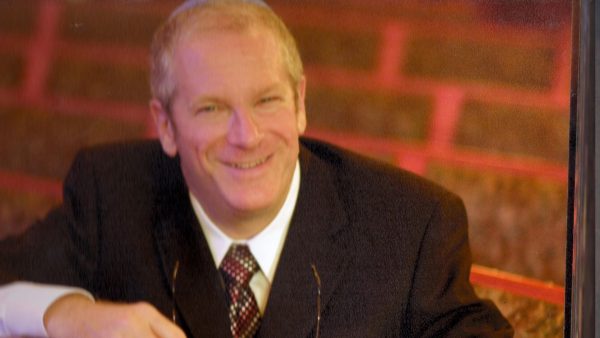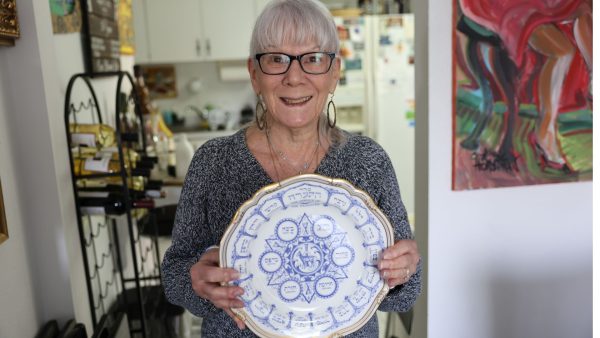Chabads on Campus are bursting at the seams, including Wash U
Shabbat and holiday meals are a cornerstone of Chabad on Campus life. During the busy seasons at the University of Kansas, the meals move outdoors into tents with seats for up to 90 students at a time. (All photos taken before the onset of Shabbat and Holidays)
Published November 2, 2022
The High Holidays are long over, and the sukkahs have come down. But if you wander into a Chabad on Campus on a Friday night, there’s a good chance you might still find them outdoors, now in a tent.
Rabbi Hershey and Chana Novack moved to St. Louis in 2002 to establish Chabad on Campus serving Washington University in St. Louis, or “Wash U.” They rapidly outgrew the dining room of their two-bedroom home and purchased a property right next to the campus, which they renovated to fit a dining room to seat 80, a small library and a space for services.
Today, the Novacks host an average of 180 students for a Shabbat meal every Friday night—and occasionally as many as 380.
What started in response to a pandemic turned out to be a long-term solution, and now, well after most activities have returned indoors, the Shabbat meals continue outside.
The Chabad-on-Campus-in-tents phenomenon is becoming more widespread as the centers become an increasingly popular spot for Jewish students. More than 260 campuses worldwide have a permanent Chabad presence, more than 185 in North America. Of those, many emissary couples report using tents during peak seasons, and dozens regularly host Shabbat meals in the outdoor structures.
And as rapidly as attendance at Chabad on Campus means and events has grown in recent years, it is expected to accelerate even more this Hakhel year, where there is a special focus on Jewish gatherings of all kinds. Once every seven years, Jews would stream to Jerusalem before the holiday of Sukkot to unite in the Holy Temple and hear the Torah read by the king. In modern times, celebrations of Jewish unity and pride throughout the Hakhel year were encouraged by the Rebbe—Rabbi Menachem M. Schneerson, of righteous memory. In addition to the millions who will be attending Hakhel celebrations throughout the year, tens of thousands are signing up to host their own Hakhel celebrations.
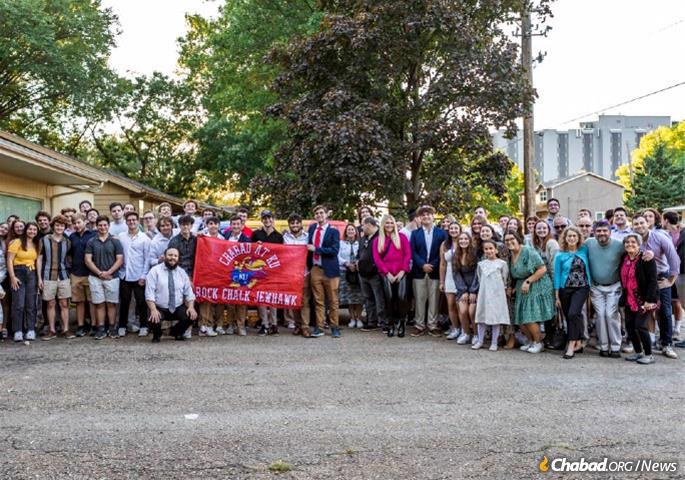
A Healthy Space to Rejuvenate
Chabad of Georgia Tech and State was founded in late 2011 by Rabbi Shlomo and Shifra Sharfstein, after a group of students petitioned Chabad headquarters for a center of their own. The Sharfsteins started off in a small rental home, with just ten students attending their Shabbat meals. The numbers slowly grew to 25, and when they moved into a building right next to the Georgia Tech campus seven years ago, attendance doubled, and pretty soon the 70-seat dining room was packed. The first Shabbat meal of September 2022 brought 120 guests.
“There wasn’t enough space,” Shifra Sharfstein describes a room so crowded that students were sitting on every available surface. “People left early to make room for newcomers, and it was upsetting to me that not everyone could just sit and enjoy. It wasn’t that amazing family vibe that we want to share.”
The next week, Chabad of Georgia Tech and State was ready with a tent in the yard and a comfortable space for everyone—something Sharfstein explained was deeply important to them.
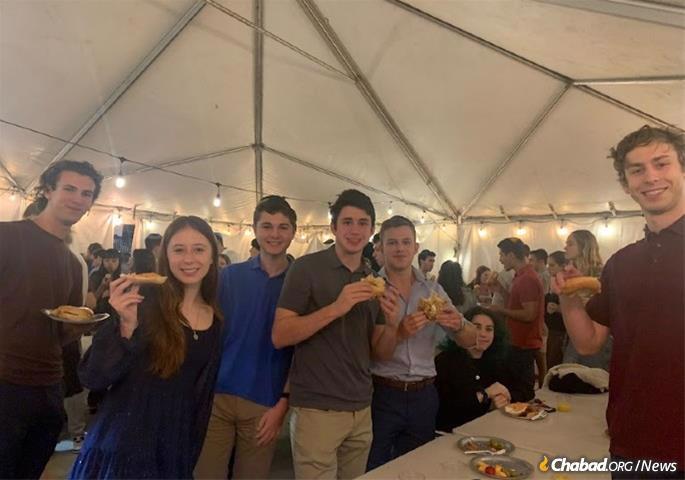
“We have a special book that our students write notes in when they graduate,” she says. “So many students write about Friday night, that knowing that they had a place to go to was something that they looked forward to the entire week. It was their highlight of the week—a good, healthy space to rejuvenate with a good boost of friends, good food and inspiration.”
Shabbat meals are a cornerstone of Chabad on Campus life. At the University of Kansas, Rabbi Nechama and Zalman Tiechtel welcome 50 students on an average Friday night, which they can fit comfortably in the Chabad dining room. During the busy seasons, the meals move outdoors into tents with seats for up to 90 students at a time.
“Students are facing a lot of struggles on campus,” explains Rabbi Tiechtel. “A lot of mental-health issues, anxiety, a lot of stress, distractions, antisemitism, and this is their safe place. They come to Chabad to have a safe haven where they can feel comfortable being themselves.”
Daniel Wachsberg is a fifth-year student at the University of Kansas. He hails from Houston and is currently studying strategic communications with a minor in business. His biggest factor in choosing a college was the Jewish presence on campus. On his first day on campus, he and his parents went to the Chabad House.
“Rabbi Zalman instantly welcomed us in as if he had known us for forever, and made us feel like family. From that day on, I felt like Chabad was home and family.”
Wachsberg describes Jewish life with Chabad at University of Kansas as a home away from home. “Although you may not know each and every person, you will always be welcomed in with a warm embrace, whether that’s a hello, just checking in on how you’re doing, or anything else.”
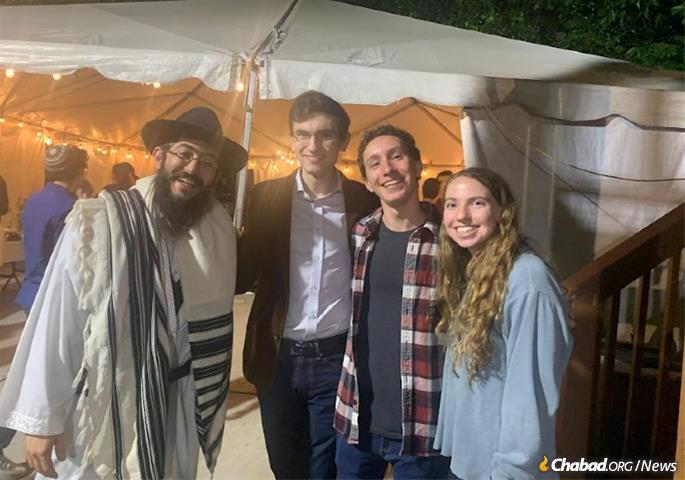
Building a Home Away From Home
The Tiechtels insist that students aren’t looking for an institution to attend, and that the Chabad House isn’t one. “It’s informal, it’s heimish and welcoming; it’s holy, and always joyful and positive.”
The effort to create that informal “home away from home” for thousands of Jewish students is monumental. Each emissary couple works to shape genuine personal relationships with the students, and make sure they feel welcomed and wanted.
The Sharfsteins can name each of their 120 most frequent students, what they’re studying, and often what challenges they’ve been facing lately. They welcome every student at the door or Shabbat table and make sure to take the time to catch up. Shifra even keeps track of students’ favorite foods.
“When they walk in I can tell them, ‘Oh, I made this angel-hair pasta because I know you love it!’ or ‘I made that dip you like, just for you!’ I want them to know that we care and think about them just like our own children.”
It’s not just the emissary couple; the students also work to cultivate the Chabad home and family.
Jacob Sloman is a fourth-year Materials Science and Engineering student at Georgia Tech and student president at Chabad. Having been raised with a Jewish mother, Southern Baptist father, and mostly Christian or secular friends, Sloman was determined to change his priorities in college and embrace his Judaism more. He set his plan in action on day one.
“At the organization fair during my orientation session, I was walking around when I saw Rabbi Shlomo and Shifra at their table, and I immediately walked up to introduce myself. And I’ve been at Chabad ever since really.”
Shifra remembers meeting him: “While welcoming incoming students at a freshmen fair, I noticed one guy whose smile was wider than the rest; his vibe was so upbeat and warm. We immediately decided he needed to join our leadership team, and I have to say it was the best hunch I’ve ever had about someone.”
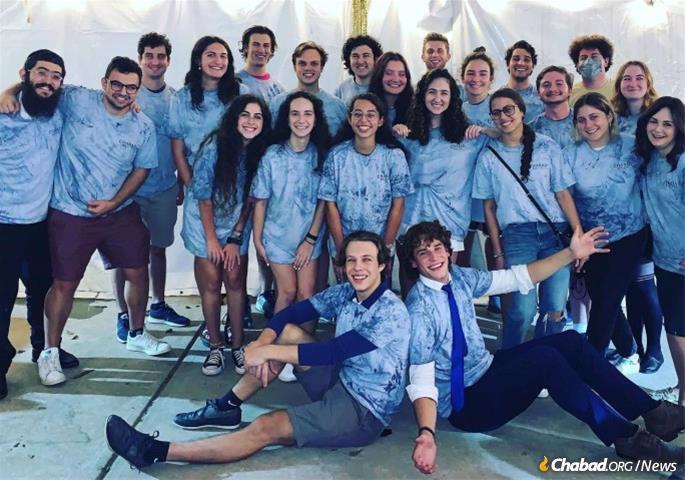
The leadership team is a diverse group of 35 students from all different backgrounds, ages and parts of campus. They each take on a small or large role and are empowered to be leaders in shaping the student life at Chabad. Three years after joining the leadership team, Sloman became student president. In his role, Sloman coordinates with other student board members, such as the Shabbat chair, holidays chair, and director of internal affairs at Georgia State. He provides resources, helps them brainstorm and collaborate, and leads discussion to see what the Jewish students need and are interested in. He also works on backend administration and organization with the rabbi.
Amid all the busy work that comes with being student president, Sloman still plays an active role in the family life of the Chabad student community. “I operate as one of a committee of ‘Soup-er Jews,’ a group that I formed to deliver soup and tea to sick students. So I also act as the resident jester, providing puns and jokes that many would file under ‘Dad humor.’ ”
Through involvement in the home and family culture of Chabad, students form deep friendships with fellow Jews.
Eitan Fredman is a first-year student studying arts and science at Wash U. He attends morning services at Chabad every day and won’t miss a Shabbat.
“It’s nice to interact with people so similar to myself,” noted Eitan. “My closest friends are people who I’ve met at Chabad.” He says you need to be there to understand why students feel so attached. “I think if you come here, you’ll see. It’s pretty obvious. The environment is great, a lot of energy, it’s just the best—it’s kind of hard to describe.”
Beyond friendships, many students meet Jewish life partners at Chabad on Campus. At Georgia Tech alone, three couples who met at Shabbat meals over the past few years are now married, or about to be.

Shabbat Meals as a Take-Home Mitzvah
Every Chabad on Campus holds their own variety of programs, catered to the interests and needs of local students. At Georgia Tech, Chabad offers a wide variety of Jewish study classes during the week, including Sinai Scholars and JewishU courses. They have a popular weekly “ChabaBBQ,” girls and guys nights out, and many programs customized around the holidays or hosted in individual Greek houses.
JewishU is also very popular at Chabad of Kansas, where they offer similar programs to Georgia Tech with an added emphasis on mental health and well-being, hosting a popular annual mental-health retreat.
At Wash U, the Jewish community is very large and diverse. In addition to the Rabbi and Rebbetzin, Chabad has a full time Israel Fellow to connect with students of Israeli backgrounds. They also have a full-time program and engagement director just to coordinate the first-year students’ welcoming and experience.
In every Chabad on Campus, the most popular program is the weekly Shabbat meals. Most campus Chabad Houses have industrial-sized kitchens, where the Chabad staff cook everything, from challah to sufganiyot (“jelly doughnuts”) and falafel, with the help of student volunteers.
Chana Novack of Chabad of Washington University theorizes that, adding to the good food and warm family vibe, students see Shabbat meals as a mitzvah they can easily take on.
“A big and open Shabbat dinner is imbued with Jewish culture and is accessible to people with no previous background or experience celebrating Shabbat. They can just walk in and experience it. It’s a model that students are able to integrate into their lives, and they can see it as something they want to do in the future and is doable. By the time they’re seniors, a lot of upperclassmen are hosting their own Shabbat meals.”
Novack predicts that Shabbat meals will be the most common element of Jewish life that students continue with, long after graduating and leaving campus.
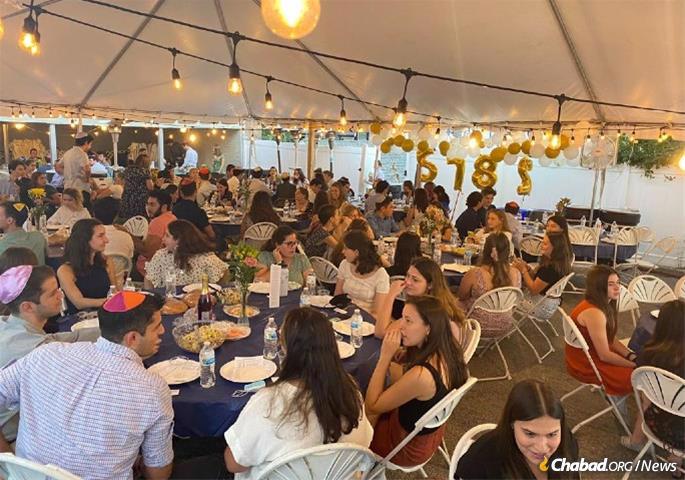
The Chabad on Campus Boom
Asked if they’re experiencing a boom in attendance, most Chabad emissaries will tell you that they’re serving more students than ever before. While much of the popularity can be attributed to the love and care given to each student, and the rejuvenating atmosphere, they also point to a new familiarity phenomena.
“When we first moved here, it was very rare to find students who had heard of Chabad before or were looking for Chabad,” says Sharfstein. “Now more than 20% of our Jewish students come to campus looking for Chabad and at least 50% have heard of Chabad before.”
Many students attending Chabad today have previously connected with Chabad through programs such as CTeens and Friendship Circle, or through their family’s involvement in the local Chabad community. After experiencing Chabad in their childhood and teen years, the students arrive at campus excited to be part of the Chabad on Campus family.
“We have good Jewish problems,” says Novack. “We’re serving 1,800 students weekly, and we cook for all of them on our own. It’s good that our problems revolve around resources and infrastructure because demand for Jewish life on campus is high.”
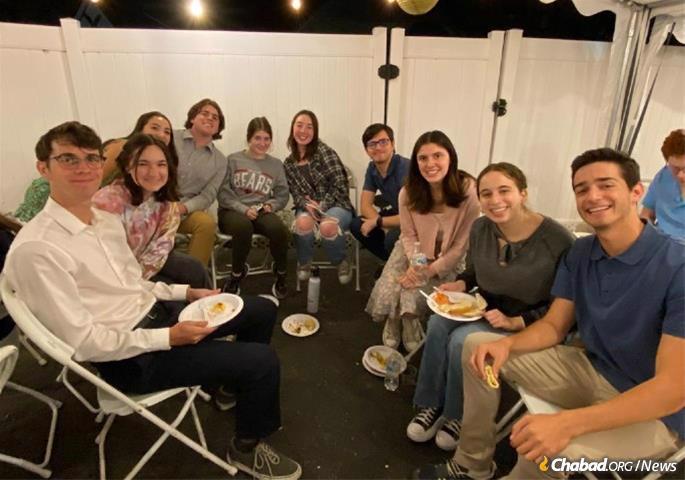
For students, it’s important that Chabad is on—or right next to—campus so that they can easily arrive by foot. This greatly limits property opportunities, especially since most universities like to own any buildings near campus. The Novacks have been searching for a larger building to purchase for 10 years now with no success.
At Georgia Tech, the weather is starting to get too cold for outdoor seating. Shabbat meals will need to return indoors, for comfort. “For now, we can squeeze inside because it’s football season,” says Sharfstein. “But as soon as that’s over, the large crowds will return, and we will need to sit in the tent again.”
The Sharfsteins are also actively looking for a larger building, and while it’s been a difficult hunt, they haven’t given up yet. “We need a larger space so that all of our students will feel comfortable and know that there’s a space for them. They shouldn’t ever feel that they’re cramped or have to move to make space for other people to come in. We’re one big family where everyone matters.”
As Rabbi Tiechtel says, “Our students should know that they have a safe place where they can go any time for any need at any time, where they will be welcome, be accepted and embraced, and experience authentic joyful Judaism.”
